
Meliaceae, the mahogany family, is a flowering plant family of mostly trees and shrubs in the order Sapindales.

In the botanical classification of plants, Aeridinae Pfitzer is a subtribe of the tribe Vandeae whose representatives all have a monopodial growth habit and do not possess pseudobulbs.
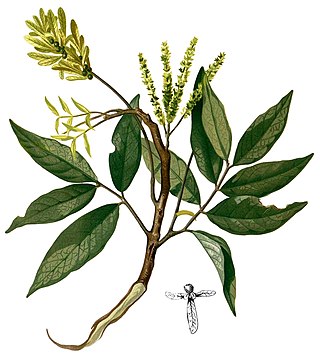
Engelhardia is a genus of trees in the family Juglandaceae, native to tropical Asia from northern India east to Taiwan, Indonesia and the Philippines. The genus name is commonly misspelled "Engelhardtia", a "correction" made by the original author Carl Ludwig Blume in 1829 and persistent until today, as it was thus entered in the Index Kewensis; the original spelling is Engelhardia.

Melastomataceae is a family of dicotyledonous flowering plants found mostly in the tropics comprising c. 175 genera and c. 5115 known species. Melastomes are annual or perennial herbs, shrubs, or small trees.
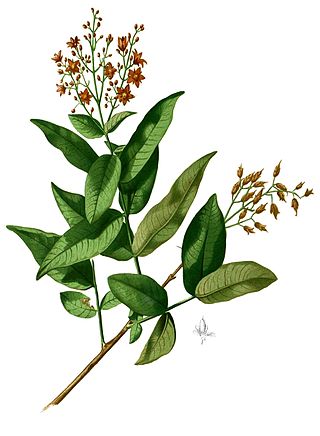
Cratoxylum is a genus of flowering plants in the family Hypericaceae, native to tropical Asia. The generic name means "strong wood", referring to the timber.
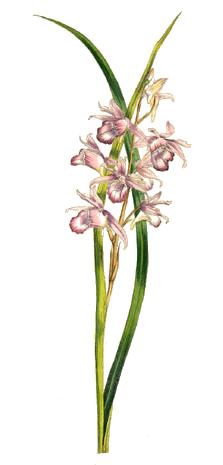
Phaius, commonly known as swamp orchids or in Chinese as 鶴頂蘭屬/鹤顶兰属 , is a genus of forty-five species of flowering plants in the orchid family, Orchidaceae. They are evergreen, terrestrial herbs which form clumps with crowded, sometimes stem-like pseudobulbs, large, pleated leaves and relatively large, often colourful flowers. Species in this genus are found in the tropical parts of Africa, Asia, Southeast Asia, New Guinea, Australia, and various islands of the Pacific and Indian Oceans. One species is also naturalized in Hawaii, Florida, and the Caribbean.
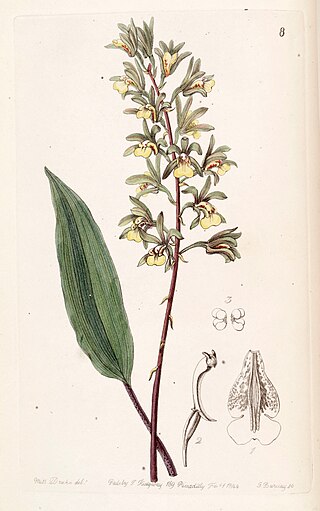
Tainia, commonly known as ribbon orchids or 带唇兰属 is a genus of about thirty species of evergreen, terrestrial orchids in the distributed from India, China, Japan, Southeast Asia to New Guinea, the Solomon Islands and Queensland.
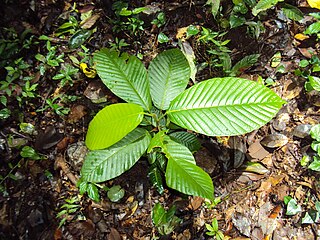
Dipterocarpus is a genus of flowering plants and the type genus of family Dipterocarpaceae.

Dysoxylum is a genus of rainforest trees and shrubs in the flowering plant family Meliaceae. About 34 species are recognised in the genus, distributed from India and southern China, through southeast Asia to New Guinea, Solomon Islands, and Australia. The name Dysoxylum derives from the Greek word ‘Dys’ meaning "bad" referring to "ill-smelling" and ‘Xylon’ meaning "wood".
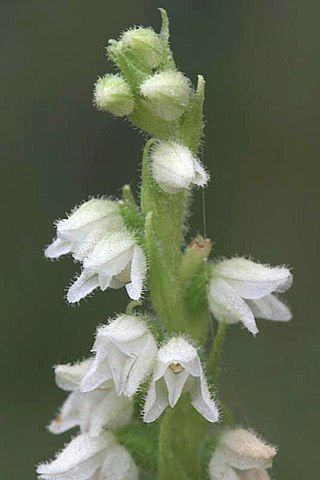
Goodyera, commonly called rattlesnake plantain, jade orchids or ladies' tresses is a wide-ranging genus of orchids in the tribe Cranichideae. About 100 species of Goodyera have been formally described. With a center of diversity in East Asia, Goodyera is found across Europe, Madeira, North and Central America, Australia, and on islands from the west Indian Ocean to the Pacific Ocean. They have a rosette of leaves at their base and usually many small white resupinate flowers. They are similar to orchids in the genus Spiranthes but can be distinguished from them by the shape and colour patterns of the leaves.
Dischidia is a genus of plants in the “dog-bane” family Apocynaceae, collectively known as the “milkweeds”. They are epiphytes, native to tropical areas of China, India as well as Bhutan’s southern borders, wherever minimal frost occurs. Additionally, they are known from most areas of Mainland Southeast Asia, including forested areas of Myanmar, Thailand, Vietnam, Cambodia, Laos, and some parts of Indonesia, Malaysia and Singapore. Several species are also native to Papua New Guinea and northeastern Australia.

Pinanga is a genus of flowering plant of the palm family in the subtribe Arecinae. It is native to eastern and southern Asia across to New Guinea.

Anacolosa is a plant genus of 15 to 22 species. In the APG IV system, the genus is placed in the family Olacaceae. Other sources place it in the segregate family Aptandraceae. The generic name is from the Greek anakolos, meaning "knotted", referring to the calyx cup rim.

Fagraea is a genus of plants in the family Gentianaceae. It includes trees, shrubs, lianas, and epiphytes. They can be found in forests, swamps, and other habitat in Asia, Australia, and the Pacific Islands, with the center of diversity in Malesia.

Glycosmis is a genus of flowering plants in the citrus family, Rutaceae and tribe Clauseneae. It is in the subfamily Aurantioideae, which also includes genus Citrus. It is a genus of the subtribe Clauseninae, which are known technically as the remote citroid fruit trees.

Rhynchostylis is a genus in the orchid family (Orchidaceae), closely allied to the genus Vanda and comprising four currently accepted species native to the Indian Subcontinent, China, Indochina, Malaysia, Indonesia and the Philippines.

Korthalsia is a clustering genus of flowering plant in the palm family spread throughout Southeast Asia. It is a highly specialized rattan with some species known to have an intimate relationship with ants, hence the common name ant rattan. High-climbing and armed with spines, the genus is named for the Dutch botanist P. W. Korthals who first collected them from Indonesia.

Cheirostylis, commonly known as fleshy jewel orchids or velvet orchids, is a genus of about sixty species of flowering plants in the orchid family Orchidaceae. Plants in this genus are terrestrial herbs with a caterpillar-like rhizome and a loose rosette of leaves. Small, white, hairy flowers develop as the leaves wither. They are found in tropical Africa, southern Asia, Southeast Asia, Malesia, New Guinea and Australia.
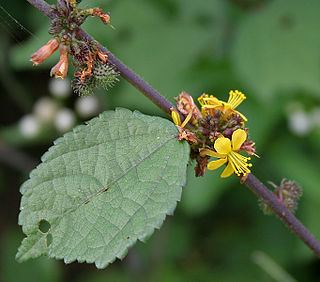
Triumfetta is a genus of plants in the family Malvaceae. Burbark is a common name for plants in this genus.
Coelospermum is a genus of flowering plants in the family Rubiaceae. The natural range of the genus is parts of southern China, Malesia, Papuasia, Australia and New Caledonia.


















